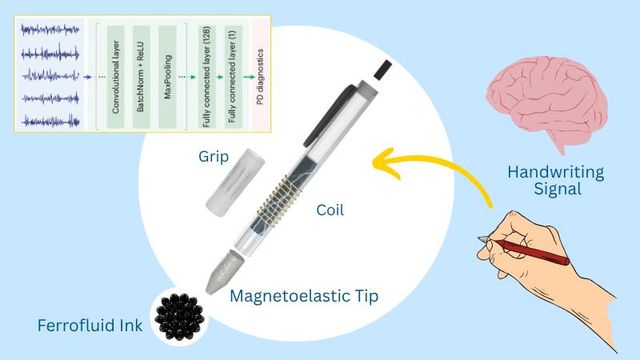Thank you. Listen to this article using the player above. ✖
Want to listen to this article for FREE?
Complete the form below to unlock access to ALL audio articles.
Every year, tens of thousands of people with signs of Parkinson’s disease go unnoticed until the incurable neurodegenerative condition has already progressed.
Motor symptoms, such as tremors or rigidity, often emerge only after significant neurological damage has occurred. By the time patients are diagnosed, more than half of their dopamine-producing neurons may already be lost. This kind of diagnostic delay can limit treatment options and slow progress on early-stage interventions. While there are existing tests to detect biomarkers of Parkinson’s, including cell loss in the brain and inflammatory markers in blood, they typically require access to specialists and costly equipment at major medical centers, which may be out of reach for many.
Led by Jun Chen, an associate professor of bioengineering at the UCLA Samueli School of Engineering, researchers have developed a seemingly simple yet effective tool: a smart, self-powered magnetoelastic pen that could help detect early signs of Parkinson’s by analyzing a person’s handwriting.
The highly sensitive diagnostic pen, described in a UCLA-led study and published as a cover story in the June issue of Natural Chemical Engineering, features a soft, silicon magnetoelastic tip and ferrofluid ink — a special liquid containing tiny magnetic particles. When the pen’s tip is pressed against a surface or moved in the air, the pen converts both on-surface and in-air writing motions into high-fidelity, quantifiable signals through a coil of conductive yarn wrapped around the pen’s barrel. Although not intended for writing, the pen is self-powered leveraging changes in the magnetic properties of its tip and the dynamic flow of the ferrofluid ink to generate data.
To test the pen’s diagnostic potential, the team conducted a pilot study with 16 participants, three of whom had Parkinson’s disease. The pen recorded detailed handwriting signals, which were then analyzed by a neural network trained to detect motor patterns associated with the disease. The model was able to distinguish participants with Parkinson’s from healthy individuals with an average accuracy of 96.22%.
“Detection of subtle motor symptoms unnoticeable to the naked eye is critical for early intervention in Parkinson’s disease,” said Chen, who is the study’s corresponding author. “Our diagnostic pen presents an affordable, reliable and accessible tool that is sensitive enough to pick up subtle movements and can be used across large populations and in resource-limited areas.”
The researchers anticipate that this pen could transform early detection of Parkinson’s and other neurodegenerative conditions. Rather than waiting for symptoms to become disruptive, primary care physicians or geriatric specialists could administer a quick handwriting test during routine visits and use the data to inform earlier referrals or treatment.
Reference: Chen G, Tat T, Zhou Y, et al. Neural network-assisted personalized handwriting analysis for Parkinson’s disease diagnostics. Nat Chem Eng. 2025;2(6):358-368. doi: 10.1038/s44286-025-00219-5
This article has been republished from the following materials. Note: material may have been edited for length and content. For further information, please contact the cited source. Our press release publishing policy can be accessed here.
